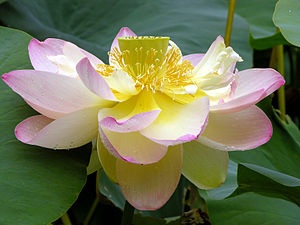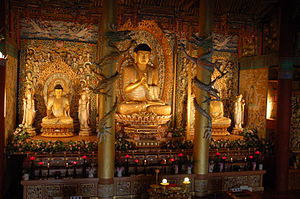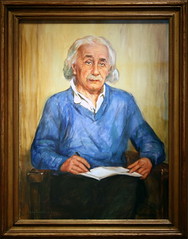 Image via Wikipedia
Image via Wikipedia
L.D. Turner
At times the search for happiness can take on the character of a greased pig at a county fair. Running, dodging, weaving, the porker seems to elude your grasp with the uncanny skills of an old Kung Fu master. And then, just when you think you have the hog in your clutches, it looks at you with a wry grin and slithers away, leaving you with an arm full of air and Oleo.
Dogen once compared enlightenment to “moonlight in a dew drop, dripping from a duck’s beak.” In a very similar vein, a very wise and eccentric old Daoist teacher I met when I lived in China said that catching a glimpse of pristine reality, shimmering in that sublime and sacred space between our thoughts, was like capturing a tiger in the ass of a gnat.
Aside from the obvious lessons here, Dogen’s teaching and that of the old Daoist both point to the fact that both happiness and the wisdom of enlightenment are found by being present to what I like to call “the divine moment.” It is precisely here, in the “sacred now” that we discover that for which many of us seek so diligently. It is right here, right now, right before us that we discover that which was never really hidden.
I don’t know about you, but I often struggle with the mindfulness necessary to discover the blessed pearls of the present moment. My mind, as the enlightened tell us, is like a monkey, jumping here, flitting there, and forever raising a ruckus of sound and fury. If this is true, and it certainly is, then my mind is often like a monkey on steroids. It just refuses to accept the tether I seek to employ. My mind, indeed, has a mind of its own.
Still, I refuse to give up on such an important issue. I make every effort to improve in this area of my life. To my way of thinking, the more mindful of the moment I am, the better my chance of discovering the divine in the mundane reality of daily living; blessings that I didn’t even know existed; and perhaps most important, messages God may have for me. I firmly believe that we often miss divine guidance because we don’t have ears to hear and the reason we don’t have ears to hear is that we are too busy and too noisy.
I have found that mindfulness and mediation are inseparable practices. The process of
meditation is, in reality, an exercise in establishing mindfulness in a specific place for a specific amount of time. The object of our meditation may vary – it could be the breath, a mantra, a prayer, a candle flame, or whatever. You see, to meditate is to be mindful and I have found that the more often and the more consistent my meditation practice is, the more I am able to be mindful when I am not meditating.
Some people complicate mediation way too much. They either turn it into some arcane practice from Inner Bhutan, complete with Tibetan chants and visualizations of everything from Indra’s Net to Shiva’s phallus. It doesn’t have to be this way, really. Countless sages from every spiritual tradition will tell you that counting the breath is enough.
Meditation also involves getting off your cushion, mat, zafu, or what have you and taking that pristine awareness into the world of your daily living. I love the following words by
Jon Kabat-Zinn about the essence of meditation and mindfulness:
We need to develop and refine our minds and its capacities for seeing and knowing, for recognizing and transcending whatever motives and concepts and habits of unawareness may have generated or compounded the difficulties we find ourselves embroiled within, a mind that knows and sees in new ways is motivated differently. This is the same as saying we need to return to our original, untouched, unconditioned mind.
How can we do this? Precisely by taking a moment to get out of our own way, to get outside of the stream of thought and sit by the bank and rest for a while in things as they are underneath our thinking, or as Soen Sa Nim liked to say, “before thinking.” That means being with what is for a moment, and trusting what is deepest and best in yourself, even if it doesn’t make any sense to the thinking mind.
From Kabat-Zinn’s words we can see that there is nothing mysterious, esoteric, or bizarre about this process of mindfulness. More than anything else, it is a simple and straightforward effort toward self-mastery, which is an essential goal on the path of spiritual evolution. Although many people tout the virtues of the undisciplined life and, as some say, “going with the flow,” this is in contradiction of the real
Zen life. If you happen to be fully enlightened and your karmic debts have been paid in full, then you might consider going with the flow. If you happen, however, to be like most of us, you will readily admit to seeing through a glass darkly and that your karmic spreadsheet still has plenty of red ink. For most of us, going with the flow will garner an experience that resembles more than anything else, the life of a log.
Again, I return to the words of Jon Kabat-Zinn, a man who lives his message of meditative mindfulness:
More than anything else, I have come to see meditation as an act of love, an inward gesture of benevolence and kindness toward ourselves and toward others, a gesture of the heart that recognizes our perfection even in our obvious imperfection, with all our shortcomings, our wounds, our attachments, our vexations, and our persistent habits of unawareness. It is a very brave gesture: to take one’s seat for a time and drop in on the present moment without adornment. In stopping, looking, and listening, in giving ourselves over to all our senses, including mind, in any moment, we are in that moment embodying what we hold most sacred in life. In making the gesture, which might include assuming a specific posture for formal meditation, but could also involve simply becoming more mindful or more forgiving of ourselves, immediately re-minds us and re-bodies us. In a sense, you could say it refreshes us, makes this moment fresh, timeless, free up, wide open. In such moments, we transcend who we think we are. We go beyond our stories and all our incessant thinking, however deep and important it sometimes is, and reside in seeing what is here to be seen and the direct, non-conceptual knowing of what is here to be known, which we don’t have to seek because it is already and always here…..In words, it may sound like an idealization. Experienced, it is merely what it is, life expressing itself, sentience quivering within infinity, with things just as they are.
From Kabat-Zinn’s description, it is obvious that coming to live in the present moment, to be mindfully attentive to what is happening in front of our eyes, is a spiritual experience of high significance. On rare occasions, we may be granted by grace a glimpse of this unadorned reality of “just what is” beyond our ideas about what is. These moments are personal epiphanies, always remembered and transformational in nature.
In essence, to meditate and become mindful in our comings, goings, risings, and fallings – in our successes and our failures and in our joys and our suffering – is indeed the experiential definition of a mainstay of the spiritual life: engagement.
To be fully engaged in the moment before us is to be truly alive, vital, involved, and useful. It is the foundation of all effective spiritual service. When we are mindful we can be engaged, and when we are engaged, really right there in our wholeness in the totality of the divine moment, we become part of the solution rather than the problem.
© L.D. Turner 2010/All Rights Reserved
 Image via Wikipedia
Image via Wikipedia











